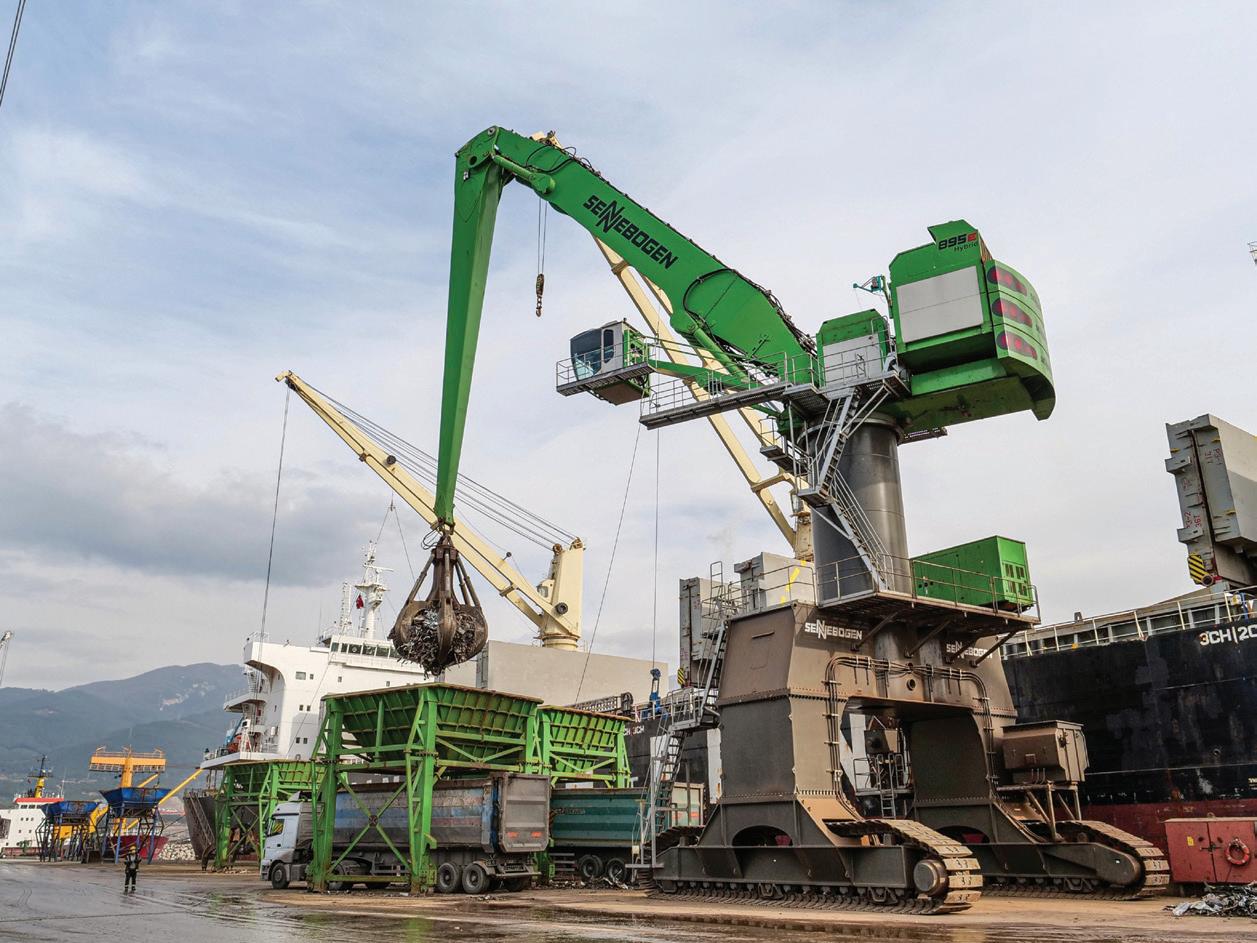
13 minute read
WORLD’S LARGEST MATERIAL HANDLER FOR SCRAP
SENNEBOGEN’S “GENTLE GIANT” FINDS A HOME IN THE PORT OF ISKENDERUN, TURKEY
The world’s largest purposebuilt conventional material handler, the 460-ton SENNEBOGEN 895 E-Series Hybrid, was originally unveiled at bauma 2019 in Germany. This massive machine was commissioned in October for the Tosyali Holdings fleet, at the Mediterranean port of Iskenderun, Turkey, in one of the country’s largest metal-producing regions.
Since then, the 895 has been moving massive amounts of scrap metal – around the clock, every day. Electrically powered, the machine never needs to take a break for refuelling, according to SENNEBOGEN, and as one observer noted, walking near the 895 conjures “images of Jurassic Park,” where tiny humans tread lightly past peacefully grazing brontosauruses.
PRODUCTIVITY ON A GIANT SCALE
Everything about this machine is big and record-breaking. A convoy of 16 trucks transported the machine to Turkey. SENNEBOGEN’s Turkish distributor, Forsen Machinery, required just a few days to assemble its gantrystyle crawler platform, configure the setup for Tosyali, and test run the 670-hp (500 kW) drive.
Fitted with a 13-yard orange peel grapple, this material handler can reach out to 130 feet (40 m) to grab 12 tons (10,900 kg) of scrap on every bite from the holds of panamax and post-panamax ships. Its operators move quickly, perched in the highly responsive and accurate elevating
Skylift cab as much as 72 feet (22 m) above ground level.
This elevated cab offers an excellent viewpoint for operators, ideal for loading and unloading bulk goods deep inside ships’ hulls. Plus, cameras mounted behind and on the right-hand side of the cab provide the operator with the 360-degree view of the entire work zone, allowing safer and faster cycle and travel times. A third camera located on the business end of the stick, near the grapple, is available, providing direct view inside holds, hoppers and other conveyor equipment.
In addition, the hydraulics of the 895 E allow for surprisingly quick cycle times.
“We handle 10,000,000 tons a year in this port alone,” says Harun Karaarslan, Tosyali’s Technical Port Director at Iskenderun.
“Our machines are in constant use. We rely on our fleet to be producing constantly – downtime would be fatal.”
The 895 material handler at Port of Iskenderun does not work alone. Tosyali’s facility operates a total of seven material handlers, including two 600,000-pound (270,000 kg) SENNEBOGEN 880 EQ balance cranes. Both the 880s also run on electric drive. Having experience with these machines, says Karaarslan, was a big part of Tosyali’s confidence in moving up to the 895.

The operator’s viewpoint from the 895E’s elevated cab is ideal for loading and unloading bulk goods deep inside ships’ hulls.

ELECTRIFYING EFFICIENCY AND ENERGY RECAPTURE
“Our experience with SENNEBOGEN machines has shown us that using electric material handlers does not mean compromising on flexibility or speed – quite the opposite,” says Karaarslan. “Despite their size, the machines cover a large work area, moving quickly up and down the pier. By not using diesel, we also save a lot of money every year.”
He notes further savings and maintenance costs, with longer service intervals and less wear on service parts than conventional diesel material handlers.
One would also expect a significant energy cost simply to move the 895’s huge lifting boom and stick – itself a 53-ton steel structure. But here again, the efficiency of the 895 is impressive according to SENNEBOGEN. Key to this efficiency is the distinctive Green Hybrid energy re-capture system engineered into the 895’s boom hydraulics. A pair of large hydraulic cylinders are mounted to either side of the main lifting cylinders. On each downstroke of the boom, the Green Hybrid cylinders hydraulically compress the gas in the storage modules at the rear of the upper carriage. On the next lift cycle, the compressed gas is released to give the lift cylinders a power assist, effectively
Model 4

The new model 4 E-Z log Baler is just what mid size scrap yards have been asking for! Priced right for any yard — small, mid size, or large! Like the Model 3, the NEW Model 4 has no set up time and a very low cost to operate. The one man operations are all handled from the newly designed cab. With the 400º rotation crane and a reach of 27’ adding the continuous rotation grapple, it makes loading the larger chamber a breeze. Taking your loose scrap to a highly sought after shreddable log.

— Cycles in under 2 minutes! — Produces up to 70 tons per day. — Fully portable in the closed position. — New seat design for more operator comfort.


offsetting the boom’s own weight, much as a compressed spring generates energy when it’s released.
As a result, SENNEBOGEN says the 895 E re-capture system saves up to 55 percent of the energy for every lift, all day long. At the port of Iskenderun, Turkey, that is a lot of lifts.
COMING TO AMERICA
Jason Jones, SENNEBOGEN’s new sales manager for the Americas, appointed earlier this year, is excited about the prospect of the 895 E for his customers in North and South America, and says the port side of the business is definitely a growing area for SENNEBOGEN. The installation in Turkey is also the first 895 E working at a port handling scrap metal, and he says it is doing very well so far in this challenging environment.
“It replaced an 880 EQ [equilibrium] machine there and they have seen a significant increase in production and efficiency, so it’s been a really good application for the 895 E,” comments Jones. He says as the biggest material handler in the world, the 895 E offers considerably more lifting capacity than conventional material handlers, as well as faster cycle times. Plus, these machines provide consistent uptime due to their design which is built around SENNEBOGEN’s concept of providing machines that are easy to operate and maintain.
He adds, “On the material handler side, with what we now

have, these machines are a real competitive advantage against larger cable cranes or equilibrium cranes, because they offer much more flexibility and versatility, and a much simpler design compared to an EQ style crane.”
Worldwide, there are now three 895 E material handlers in service, two in Turkey and one in Europe, with the first one in North America scheduled for delivery in early 2021.

U.S.-imposed aluminum tariffs are the last thing needed
RECYCLED ALUMINUM NEEDS TO BE KEPT OUT OF ANY COUNTER-TARIFFS IMPOSED AS A REACTION TO LATEST U.S. TRADE POLICY
BY KEITH BARKER, EDITOR
On August 6, U.S. President Trump signed a proclamation reinstating a 10 percent tariff on non-alloyed, unwrought aluminum from Canada, which began on August 16, 2020. According to the U.S. government, certain types of aluminum entering the U.S. are depressing the industry there, including an 87 percent surge in imports of primary aluminum from Canada since May 2019.
Trump’s government stated that the tariff will remain in effect “unless such actions [import volumes that harm U.S. national security] are expressly reduced, modified or terminated.”
Of relevance to the recycling industry specifically is the fact that while the proposed U.S. tariffs are focused on primary metal and do not include scrap aluminum, it is included in the Canadian government’s proposed list of materials to be considered in dollar-fordollar counter measures, and for the first time ever.
According to the Canadian Association of Recycling Industries (CARI) President Tracy Shaw, the inclusion of recycled aluminum on the Canadian list of materials to be included in any counter-tariffs is of great concern to the Canadian recycling industry.
“This is obviously of concern for us, and our members are concerned,” she says. “Scrap is a very important link in the North American manufacturing supply chain. Especially now, we want to make sure that supply chains are kept moving and frankly we need manufacturers to get back to capacity, to get back to ramping up production and running smoothly. And consumers need the material, especially metals.
“The timing is really unfortunate, because our manufacturing and recycling industries in North America are like one industry,” she continues. “We’re heavily integrated, and we have materials moving across the border several times throughout a given processing and production cycle.”
She says the metals industry is still trying to make up for diminished supplies resulting from the COVID-19 shutdown this past spring, and emphasizes that Canada does not want to open the door to the implementation of U.S. tariffs on aluminum scrap, as a reaction to Canada’s reactionary counter measures.
“Once that door is open, we would rather not see the U.S. then put tariffs on scrap aluminum, because all it does is hurt our industry. It hurts our manufacturers, and it would increase costs
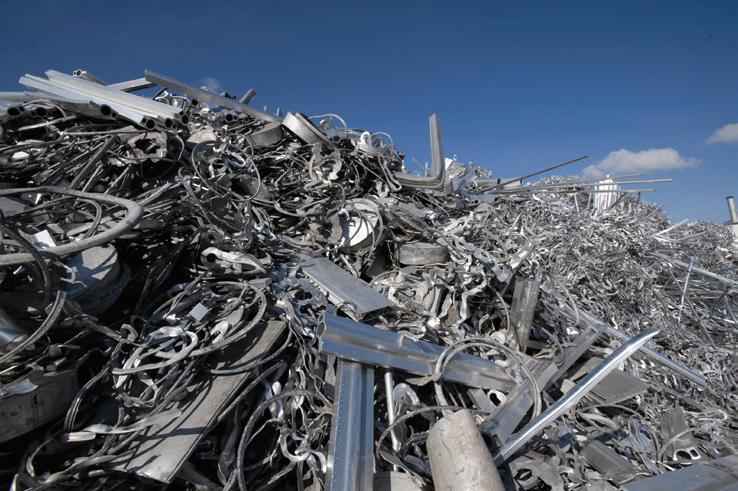
across the board at a time when that’s just not viable.”
“I think we need to just keep pushing forward the idea that we are basically one industry, one North American industry, for which the free flow of material is essential. CARI is going to do everything we can to let our government know that we feel that scrap needs to be excluded from any counter measure tariffs.”
Shaw concludes, “We have always supported and believed in free and fair trade, and that the free flow of scrap across our borders is mutually beneficial for the U.S. and Canada. They are our biggest trading partner, definitely in terms of aluminum scrap, but we are one of theirs as well. So, it is of great concern to our members who have already seen second quarter exports of aluminum scrap this year down significantly because of the COVID-19 shutdown.
“We’re at a point where what we’re trying to do is get back to a state of normalcy. This is really the last thing our members need.” RPN
Canada-wide initiative launched to improve e-waste reuse and recycling
CREATE SEED INITIATIVE LAUNCHED BY POLYTECHNIQUE MONTRÉAL
Polytechnique Montréal has launched the Canada-wide Collaborative Research and Training Experience in Sustainable Electronics and Eco-Design (CREATE SEED) initiative, which will bring together some 20 Canadian and international universities and industrial partners to improve the way e-waste is reused and recycled, and promote eco-design.
Incessant demand for electronic equipment produces huge amounts of waste, and in 2016 alone, global e-waste volumes amounted to 44.7 megatonnes – including 724 kilotonnes from Canada. Although e-waste contains substances that are hazardous to human health and the environment, it also contains precious metals. As an example, one tonne of mobile phones contains about 100 times more gold than a tonne of gold ore. The CREATE SEED initiative intends to optimize the way valuable materials are gathered from e-waste, while at the same time rethinking how the electronics supply chain functions.
CHANGING THE E-WASTE PARADIGM
Professor Clara Santato, (Department of Engineering Physics) is an expert in organic electronics at Polytechnique Montréal, and is leading the CREATE SEED project. Her team and partners have been awarded $1.65 million over the next six years for this initiative, granted by the federal government’s Natural Sciences and Engineering Research Council of Canada (NSERC) CREATE program.
The project will bring together 50 researchers, students and partners, and includes both training and research

objectives. The first objective seeks to change conceptual thinking paradigms about electronics, break down information silos and eliminate blind spots – particularly in the field of ecotoxicology, and in terms of raising awareness about the universal nature of the e-waste problem. The CREATE SEED program intends to innovate in this manner by establishing a radically different approach to training the next generation of engineers, designers and analysts, to transform their vision of e-waste, thereby alleviating electronics’ environmental footprint.
In terms of research, CREATE SEED will rethink electronic product design, using the best of conventional inorganic electronics and emerging organic technologies, combined with the development of manufacturing processes that minimize e-waste’s environmental footprint. An example of their innovative plans include smartphones made from biodegradable, upgradable components (e.g. organic transistors, organic light-emitting diodes) that also use organic materials (e.g. melanins, tannins, lignin, green chemistry materi als) to curb e-waste production and its associated pollution.
The initiative comprises 20 researchers from Polytechnique Montréal, Institut national de la recherche scientifique (INRS), McGill University, the University of Toronto, the University of Waterloo, and the University of British Columbia. It is also supported by the National Research Council of Canada, École de technologie supérieure (ETS), HEC Montréal, the Printability and Graphic Communications Institute, the Université de Montréal, the Université de Sherbrooke, New York City University’s Queen’s College, the University of Nigeria – Nsukka and United Nations University.
UN Global E-waste Monitor 2020 predicts electronic waste volume to reach 74 million tonnes by 2030
According to the UN Global E-waste Monitor 2020 report released this summer, worldwide generation of e-waste is up over 20 percent since 2015 and is set to double in a decade. The report finds a record 53.6 million metric tonnes of electronic waste was generated worldwide in 2019, up 21 percent in only five years, and predicts global e-waste (defined as discarded products with a battery or plug) will reach 74 million tonnes by 2030, amounting to close to a doubling of e-waste volumes in 16 years. This makes e-waste the world’s fastest-growing domestic waste stream, fuelled mainly by higher consumption rates of electric and electronic equipment, short life cycles, and few options for repair.
UN’s Global E-waste Monitor 2020 also found that only 17.4 percent of e-waste generated in 2019 was collected and recycled. This means that gold, silver, copper, platinum and other high-value, recoverable materials, conservatively valued at US$57 billion – a sum greater than the Gross Domestic Product of most countries – were mostly landfilled or burned, rather than being collected for reuse and recovery.
Also according to the report, regionally, Asia generated the greatest volume of e-waste in 2019 (approximately 24.9 Mt) followed by the Americas (13.1 Mt) and Europe (12 Mt), while Africa and Oceania generated 2.9 Mt and 0.7 Mt respectively.
The UN’s Global E-waste Monitor 2020 is a collaborative product of the Global E-waste Statistics Partnership (GESP) formed by UN University (UNU), the International Telecommunication Union (ITU), and the International Solid Waste Association (ISWA), in close collaboration with a range of partners.
International E-Waste Day is October 14
International E-Waste Day has been developed by the WEEE Forum, an international association of e-waste collection schemes, and its members. The day is meant to promote the correct disposal of e-waste throughout the world, and highlight to consumers the importance of repairing or correctly disposing of their used appliances with the aim to increase re-use, recovery and recycling rates.
E-waste is the world’s fastest growing waste stream, increasing in volumes at a rate of about 3 to 4 percent per year.

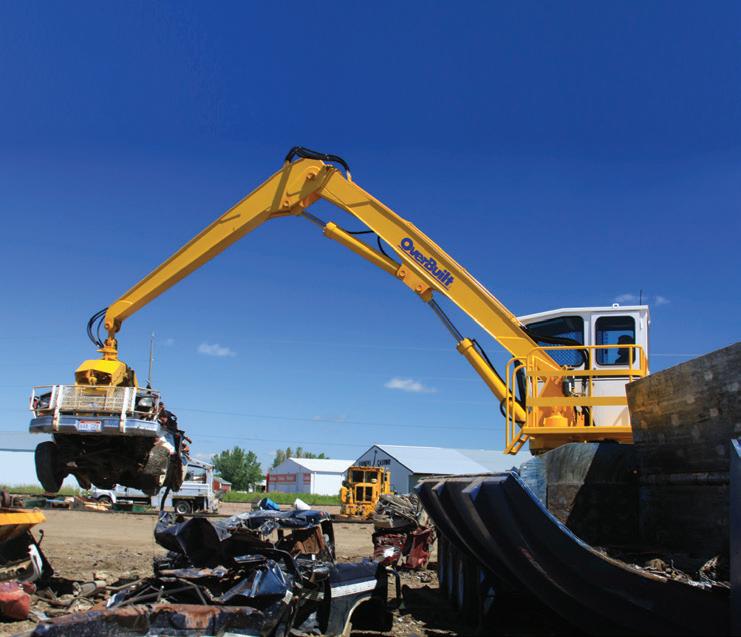
high-speed Car Crushers & baler loggers
customized options available!
OverBuilt Car Crushers boast the highest opening and fastest cycle times in the industry. The crane on our Baler Logger has a 26.5-foot reach with a 5000 pound lift at 25 feet.

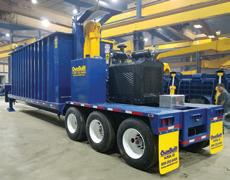
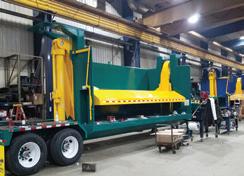
overbuilt.com |
OVB HOLDINGS, LLC

sales@overbuilt.com | 800-548-6469 | 605-352-6469




